Gray rot of grapes: description of the disease, control measures, how to spray (fungicides for treatment)
The berries of your grapes suddenly began to become covered with a gray bloom and rot, the harvest began to literally disappear even on the bush. A familiar situation, isn't it? No wonder you decided to look for information on measures to combat gray rot.
Next, you will learn how to deal with gray rot of grapes, how (with what drugs) to treat it to protect and treat this dangerous fungal disease.
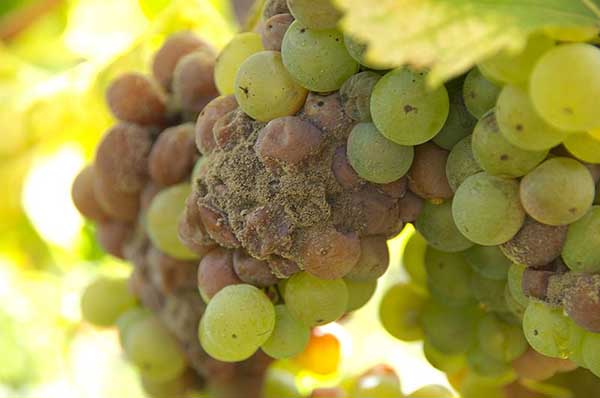
Content
- 1 Gray rot of grapes: description of the disease, causative agent, favorable conditions for development, symptoms of damage
- 2 Agrotechnical measures for the control and prevention of gray rot
- 3 When to spray grapes from gray rot: treatment scheme
- 4 How and what to treat grapes from gray rot: spray preparations
Gray rot of grapes: description of the disease, causative agent, favorable conditions for development, symptoms of damage
Gray rot, along with oidium and mildew, is one of the most dangerous and harmful diseases of grapes.
The causative agent of gray rot is mushroomBotrytis cinerea (Botrytis Bunch Rot), which also affects other cultures (especially strawberries, sometimes even tomatoes).
By the way! The disease is often called so - "Botrytis".
Typically, the fungus hibernates as mycelium on the surface and inside the bark of annual shoots, often on the ridges (skeleton of a grape bunch).
But it can also overwinter in the form of sclerotia on dead and poorly ripened parts (annual shoots) of the bush.
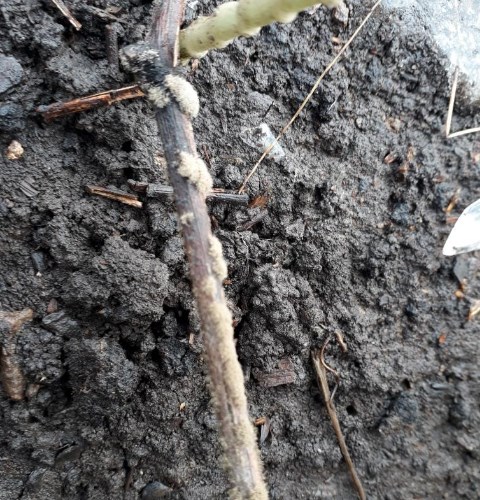
- When and how does infection occur?
Already with the first positive temperatures, i.e. from early spring (at temperatures above +5 degrees), and especially under favorable weather conditions (humid and warm weather, frequent and prolonged rains), conidia begin to actively form and germinate, with the help of which infection occurs.
Important! For conidia to germinate, they must be in a drop of water or water film for at least 2 hours.
At a temperature of +15 .. + 27 degrees, germination occurs after 2-4 hours (with a humidity above 90%), at temperatures below +15 and above +27 degrees, germination takes noticeably longer (from 5 hours).
But in hot (above +30 .. + 32 degrees) and dry weather, the fungus does not develop (conidia do not germinate).
- What is the danger of infection of grapes with gray rot?
The fungus affects all green parts of the bush: young annual shoots, leaves, inflorescences and berries.
- In early spring, in cold and damp weather, the fungus will coat blossoming buds and young shoots, thereby causing them to die off.
- Later, under more favorable conditions, the fungus can cover in a circle gray bloom more mature young shoots, provoking their wilting or breaking off (at the site of infection).
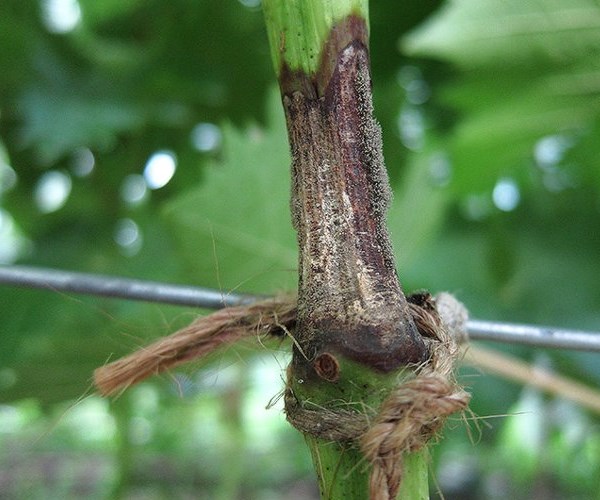
- If spring is cool and damp, then on young leaves brown (necrotic) spots are formed.
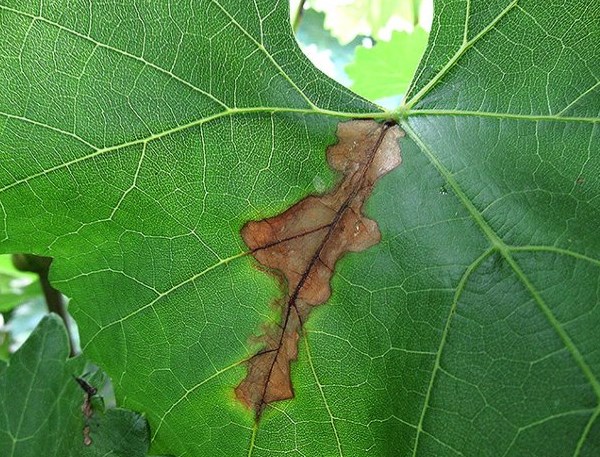
- Often, a series of rot affects grapes even at the stage of formation inflorescences, because of which they die off (turn brown and dry out) and the berries do not tie (looks like paralysis of the ridges).
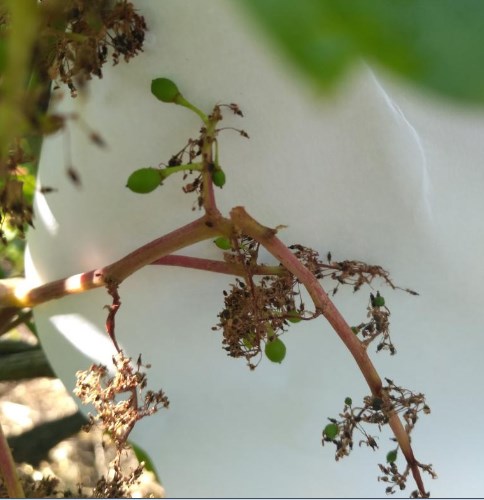
Interesting! Infection begins in the leaf axils or from the inflorescence stalk. infection occurs as a result of the accumulation of moisture in these parts of the plant, where it persists for a long time.
- Also, the fungus can infect vaccinations, due to which the percentage of survival rate of cuttings is noticeably reduced.
Of course, stronger and most often affected berries (during their ripening period), due to which the yield and keeping quality are noticeably reduced.
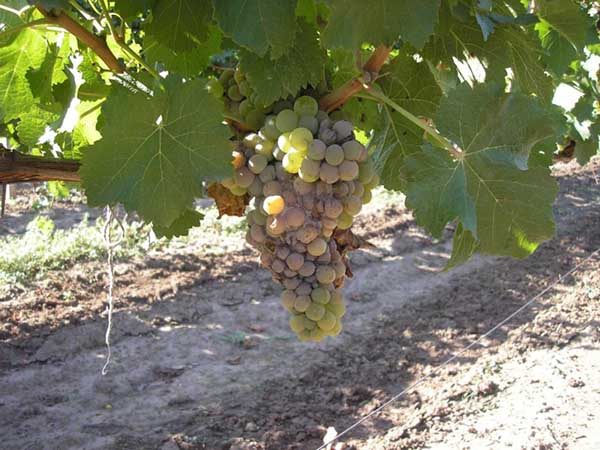
As a rule, berry infection (and their subsequent decay) occurs after the start of ripening and accumulation of sugar in the berries.
The fact is that in addition to the presence of water, for germination of conidia of the fungus also requires nutrients, namely simple sugars (fructose or glucose).
Most often, infection begins with those bunches in which the berries were damaged in some way (hail, wasps or birds, as a result of sunburn, cracking due to damage oidium or wrong mode glaze).
This is due to the fact that the juice is both essential moisture and nutrient, which are necessary for the early germination of the fungus conidia.
- What are the symptoms (signs) of lesions of grapes gray rotten?
Infected berries acquire gray-brown color, a if the weather is wet, then they additionally form gray bloom (if touched, it will look like dust).
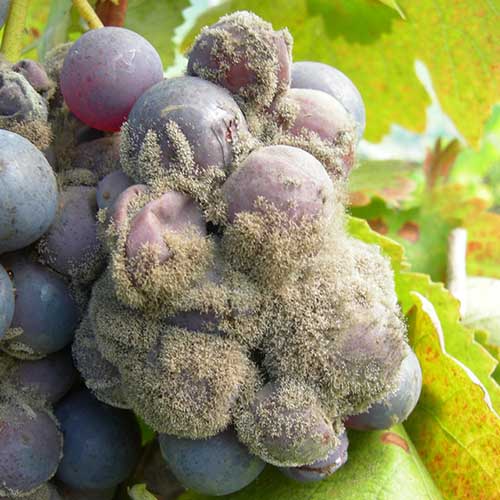
Subsequently, the entire bunch gradually begins to rot.
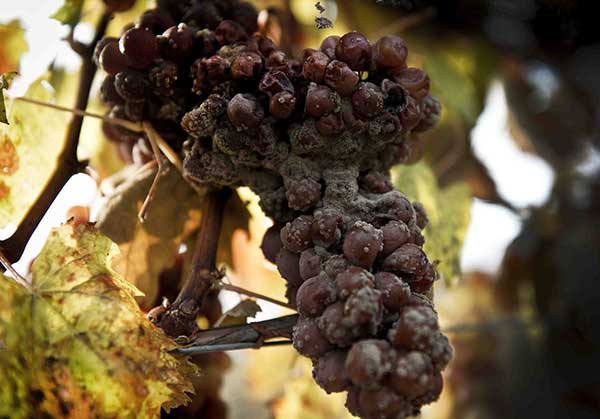
And in dry weather, the affected berries are simply shrink.
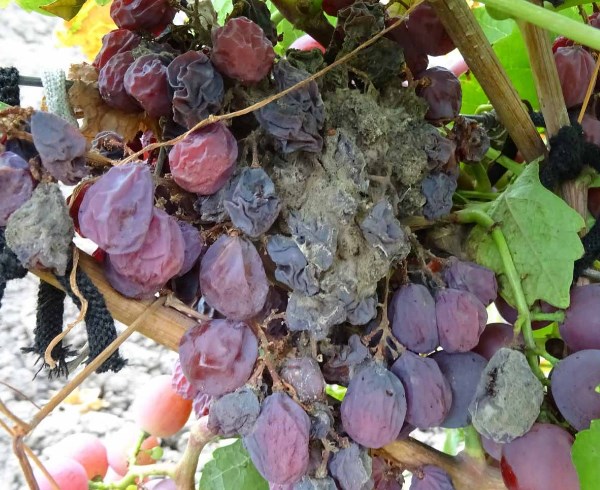
Note! The grapes also hit and other rot:
- white rot;
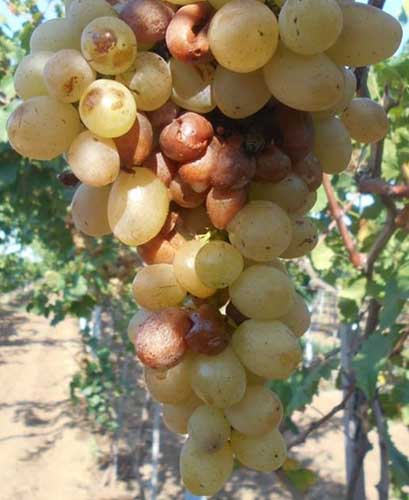
- black rot.
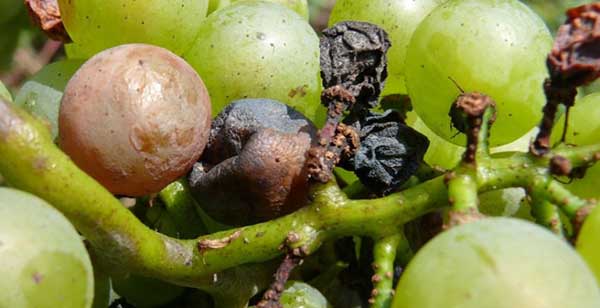
Agrotechnical measures for the control and prevention of gray rot
So the most favorable circumstances (apart from warm and humid weather conditions) and mistakes of agricultural technologythat contribute to the development of gray rot on grapes are:
- Damage to berries by fungal diseases (anthracnose, white rot and especially oidium), hail, wasps and birds, them malfunction cracking glaze.
- Growing varieties with very dense bunch and / or thin skin.
- Thickening landings, poor ventilation of the bushes (especially during the flowering period and the beginning of the formation of berries).
- Excessive application nitrogen fertilizers in the second half of the growing season.
Accordingly, in order to weaken or stop the development of gray rot, you need to follow the rules of agricultural cultivation, as well as plant the most resistant variety.
Resistant variety
First, to reduce the likelihood of grape mold infestation, you should to plant the most resistant, more precisely, less damaged grape varieties, in which:
- sufficiently thick skin;
Mechanical barrier to the penetration of infection into the berry.
- clusters are looser;
Obviously dense clusters dry more slowly after rain.
Moreover, when filling and ripening, berries in dense bunches can simply squeeze each otherthereby causing damage to the skin.
- berries are less sugary (neutral taste).
The maximum susceptibility of berries to gray mold damage is achieved when the accumulation of sugars exceeds 15 grams per 100 cm3.
Respectively, table grapes less susceptible to gray rot than technical (wine).
Proper care and cultivation techniques
The most important agrotechnical measure for the prevention and protection of grapes from gray rot is to create conditions for speedy drying of the bushes during the rainy season, in other words, grape bushes, especially near bunches, should well ventilate.
- How to improve the ventilation of the bushes?
The following factors can affect the ventilation of the crown of vines:
- the location of the site (it is obvious that the lowlands are always damp and wetter);
- distance between bushes;
- garter method (trellis type);
- trim length.
So, remember what the most favorable conditions are for the development of gray rot!
That's right, this is a dense and thickened crown that is poorly ventilated, which is why the clusters dry out very slowly after rain.
We remind you! The most important factor in the development of gray rot is the prolonged (from 2 hours) presence of moisture (water film).
How can you reduce the density of the crown and, accordingly, reduce the development of gray rot?
Do not forget to regularly conduct summer ("green") grape pruningwhich provides for the following green operations:
- pinching (before or at the beginning of flowering, i.e. at the beginning of summer - around June);
- minting (summer in July and autumn in August);
Advice! Read more about pinching and chasing in this material.
- pinching (after flowering and during the entire period, while the plant is pinching, it gives side shoots);
Important! The site also has a separate material about when and how to pinch grapes.
- removal of whiskers and other green operations (removal of part of the leaves in the fruit zone in autumn, after the heat, as well as thinning of inflorescences and / or brushes, fragments of shoots).
Thus, thanks to the removal of leaves and stepsons' shoots (stepsons) in the area of the bunch, you can achieve its better ventilation, which means that you will reduce the risk of developing gray rot.
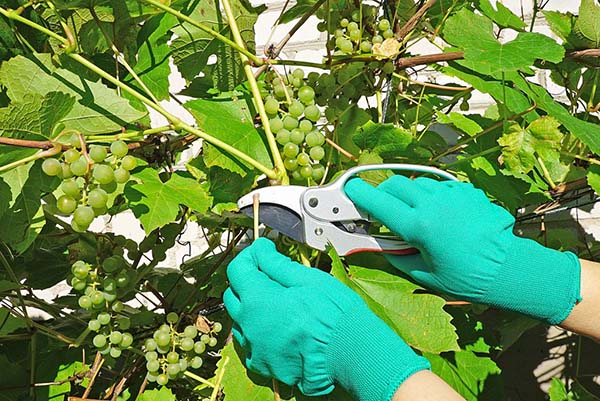
However! Green operations require correct and timely implementation.
The fact is that you can simply, on the contrary, provoke a thickening of the crown (pinching and chasing, as a rule, causes strong growth of stepchildren), and excessive removal of leaves can cause damage to berries from sunburn (you can only remove leaves from the east side, with doing this after the stage of "peas" (in no case before).
Other agronomic methods of protection and control of grape gray rot:
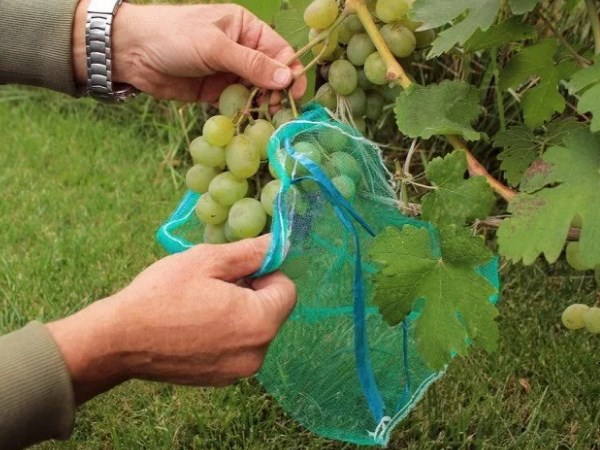
- Mandatory protective measures and spraying with fungicides against powdery mildew.
- Proper watering, especially during the ripening period of grapes.
Important! In no case you can't sprinkle ripening grapes.
- Top dressing potash (potassium sulfate, wood ash) and phosphoric fertilizers during the period of filling and ripening of berries.
The fact is that strength and elasticity skins depend on the presence of grapes in the diet phosphorus, a thickness — potassium... Accordingly, with a deficiency of these macronutrients, the skin loses its strength. A excessive nitrogen applicationon the contrary, it leads to an increase in the size of the pulp without thickening the shell; as a result, it stretches, becoming thin and fragile.
Nitrogen fertilizers required by the plant only in the first half of the growing season.
- If the berries are still began to crack, but in small quantities, then individual damaged copies can be tried promptly cut with scissorsto prevent the spread of the disease to the entire bunch. If cracked most of the bunchthen better than her remove completely.
When to spray grapes from gray rot: treatment scheme
The most dangerous periods (= favorable) for infection with gray rot are the following phenophases in the development of grapes:
- on early and mid-season varieties - flowering, closing of berries in bunches and the beginning of ripening of berries;
- on late-ripening varieties - the phase of the beginning of ripening of berries and 3-4 weeks before harvesting.
Thus, it is recommended to carry out protective and therapeutic treatments of grapes from gray rot:
- during the period of inflorescence protrusion, i.e. before flowering (Horus) - for prevention (protection);
- during flowering and berry formation (Horus, Skor, Teldor, Switch) - for prevention (protection) and treatment;
If it rains during flowering, then processing will not only be very helpful, but downright obligatory.
- in the period before the berries close, at the beginning of the coloring and ripening of berries (Switch, Teldor) - for protection and treatment (preferably 2 treatments).
Most important processing grapes from gray rot carried out before closing berries in a bunch (3-4 weeks before harvest).
How and what to treat grapes from gray rot: spray preparations
So, with when you figured out when to process grapes, now you just have to understand how to most effectively carry out the spraying themselves and what fungicidal preparations (agents against diseases) can be used.
How to spray correctly
- Processing must be carried out in preventive mode, trying to prevent the onset and development of the disease.
Wherein processing will be more efficientif you spend it before the rain, not after... In other words, you need to carefully follow the weather forecast.
- Contact preparations are washed off by rain, which means that if it rains after processing, then it needs to be repeated every other day.
And here systemic drugs within 3-4 hours get inside the plant and the rain does not wash away, which means that, regardless of the weather, processing is carried out according to the regulations.
- If you find first signs of illness on the bush, then you need to apply fungicides already with a therapeutic effect (or protective and therapeutic).
- Preparations for processing should change periodically, i.e. use alternately (do not apply more than two times in a row) so that there is no resistance (the fungus could not adapt to the active substance of the drug).
This should change not the name of the drug, but the active ingredient.
- When severe infection should be treated tank mixture of 2 preparations (with different active ingredients).
- Before using carefully read the instructions for the drug, be sure to check the dosage, frequency of use and waiting period (how many days after processing the fruits can be eaten).
The fact is that the most active development of gray rot occurs at the end of the ripening of grapes, and waiting period some chemicals have long enough (30 days or more), in other words, they cannot be used. And here at biological agents waiting period it may not be at all or it is minimal (1-3 days).
Chemical fungicides
Chemical preparations for the protection (prevention) and treatment of gray rot of grapes (the active ingredients are indicated in brackets, as well as the method of penetration and the nature of the effect):
Many preparations for gray rot of grapes are sold only in large containers (for professional farmers), for summer residents (personal subsidiary farms) in small packages you can find Skor, Horus, Medea, Tilt (Forecast, Agrolekar), Profit Gold, Teldor and Switch (only in Ukraine), Acrobat MC, Bayleton, Fundazol and Topsin-M.
- Cosside 2000 (copper hydroxide, contact fungicide of protective action).
- Bravo (Chlorothalonil, contact fungicide of protective action);
- Poliram DF (Metiram (Polycarbocin), contact fungicide of protective action);
- Buzzer (Fluazinam, contact fungicide of protective action);
- Merpan (Captan, contact fungicide of protective action);
Analog - Tuning Fork.
- Rovral (Iprodion (Rovral), contact fungicide of protective and healing action);
- Tersel (Dithianon and Pyraclostrobin, contact fungicide of protective and healing action);
- Moon Experience (Pyrimethanil and Fluopyram, a systemic fungicide of a curative action);
- Moon Tranquility (Pyrimethanil and Fluopyram,systemic fungicide of a curative action);
- Wagon (Tebuconazole, a systemic fungicide of protective and healing action);
- Folicour (Tebuconazole, a systemic fungicide of protective and healing action);
Analogs - Kolosal, Ikarus, Tebuzol.
- Collis (Boscalid and Kresoxim-methyl, a systemic fungicide of protective and healing action);
- Cantus (Boscalid, systemic fungicide of protective action);
- Bellis (Boscalid and Pyraclostrobin, systemic contact fungicide of protective action);
- Signum (Boscalid and Pyraclostrobin, systemic contact fungicide of protective action);
- Teldor (Fenhexamide, local systemic fungicide of protective action);
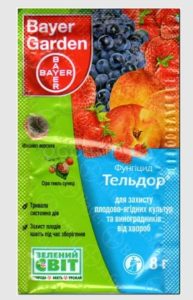
- Topaz (Penconazole (Topaz), systemic fungicide of protective action);
Note! The tool has a rather weak effectiveness. Suitable only for prophylaxis if the weather is not very favorable for the development of the fungus (rare rains).
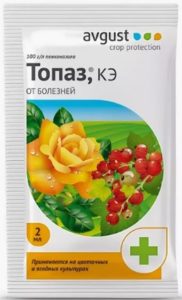
- Switch (Fludioxonil and Cyprodinil, contact-systemic fungicide of protective and curative action);
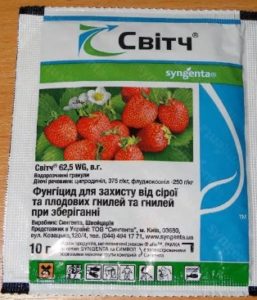
- Tilt (Propiconazole, systemic fungicide of protective and curative action);
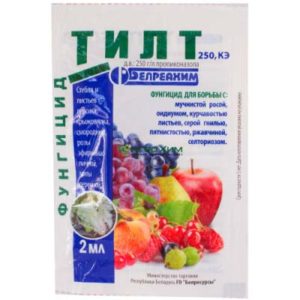
Analogs - Agrolekar, Forecast, Chistoflor.
- Title 390 (Propiconazole, systemic fungicide of protective and curative action);
- Acrobat MC (Dimethomorph and Mancozeb, systemic contact fungicide of protective action);
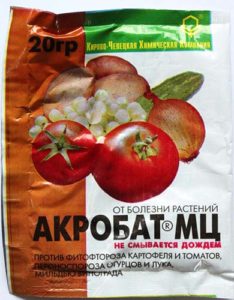
- Speed (Difenoconazole, systemic contact fungicide of protective and curative action);
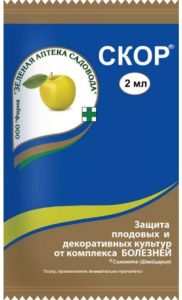
Analogues - Raek, Guardian, Purest flowers.
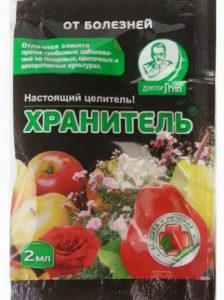
- Horus (Cyprodinil, a systemic fungicide of protective and healing action);
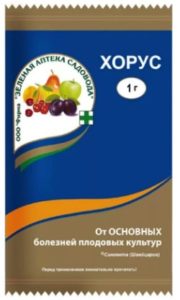
- Bayleton (Triadimefon (Bayleton), systemic fungicide of protective and healing action);
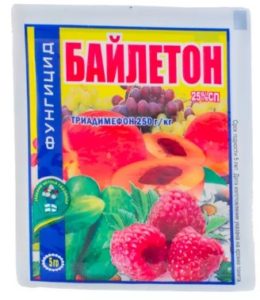
Analogs - Bizafon, Privent.
- Medea (Difenoconazole and Flutriafol, systemic contact fungicide of protective and curative action);
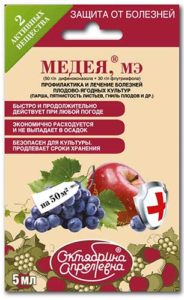
- Profit Gold (Famoxadone and Cymoxanil, systemic contact fungicide of protective and curative action);
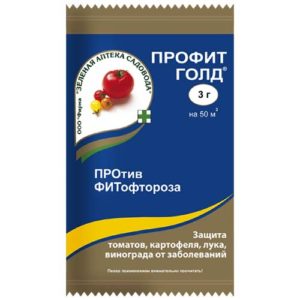
Analogs - Thanos, Ulisses.
- Fundazol (Benomil (Fundazol), systemic contact fungicide of protective action);
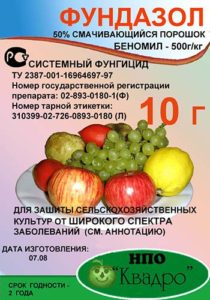
- Topsin-M (Thiophanate methyl, systemic contact fungicide of protective action);
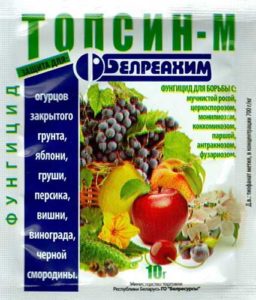
Analogs - Thiophene, Thioma.
- Rex Duo (Thiophanate-methyl and Epoxiconazole, systemic contact fungicide of protective and healing action).
Biologicals
If you are against the use of chemicals, then you can fight gray rot on grapes with the help of regular spraying with biological preparations (the active ingredients are indicated in brackets, as well as the method of penetration and the nature of the effect):
Biologicals fungicidal action:
- Alirin-B (Bacillus subtilis strain B-10 VIZR, systemic contact fungicide of protective and curative action);
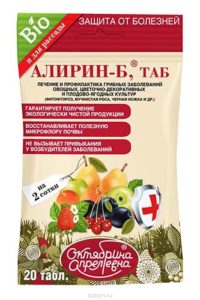
- Gamair (Bacillus subtilis strain M-22 VIZR, systemic contact fungicide of protective and curative action).
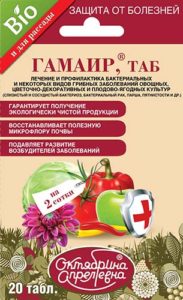
- Fitosporin (Bacillus subtilis strain 26 D, systemic fungicide of protective and curative action);
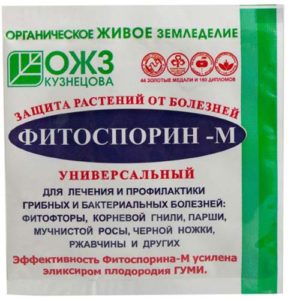
- Baxis (Bacillus subtilis strain 63-Z, protective and curing fungicide);
- Sporobacterin (Bacillus subtilis and Trichoderma viride, strain 4097, systemic contact fungicide of protective and therapeutic action);
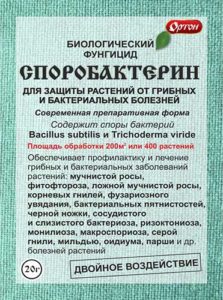
- Planriz (Pseudomonas fluorescens strain AP-33, contact fungicide);
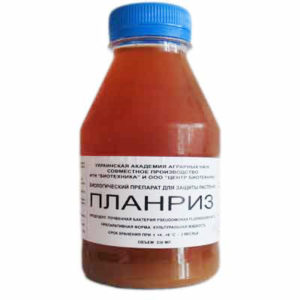
- Rizoplan (Pseudomonas fluorescens strain AP-33, contact fungicide);
Planriz and Rizoplan are complete analogues.
- Trichoderma Veride (Trichoderma veride, strain 471, protective fungicide);
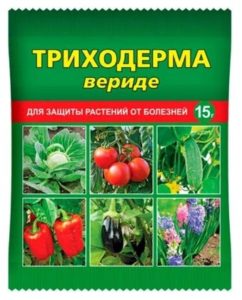
- Trichoplant (Trichoderma lignorum, protective fungicide);
- Trichocin (Trichoderma harzianum, protective fungicide);
Trichodermin, Trichoplant, Trichocin and Trichoderma Veride are all based on Trichoderma mushrooms.
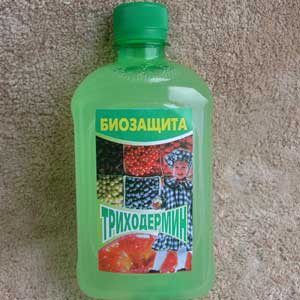
- Glyocladin (Trichoderma harzianum strain 18 VIZR, systemic contact fungicide of protective and curative action;
- Gaupsin (two strains of soil bacteria Pseudomonas aureofaciens, insectofungicide complex action).
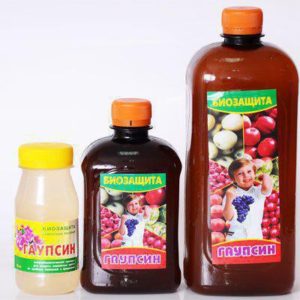
Folk remedies
As folk remedies to combat grape gray rot, some gardeners recommend using solutions:
- baking soda (from 0.5% solution to 2-3%);
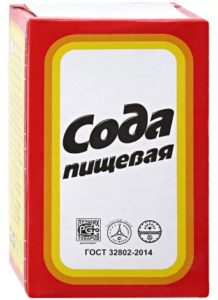
In general, calcined can also be used.
- potassium permanganate (potassium permanganate).
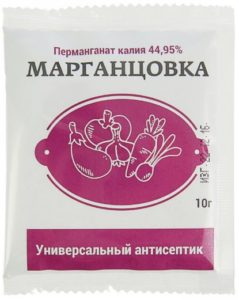
Moreover, it is desirable to prepare exactly the tank mixture, i.e. it is best to mix both components together.
Well, now you have all the necessary information about what gray rot is, as well as how you can fight it on grapes, including when, how and with what (what fungicides) it is better to process. Good luck!

